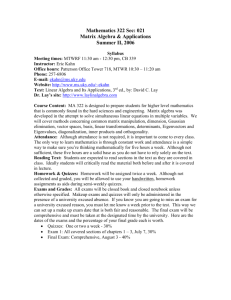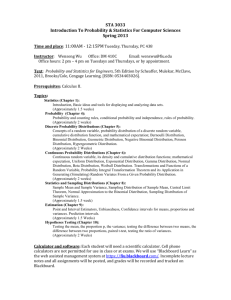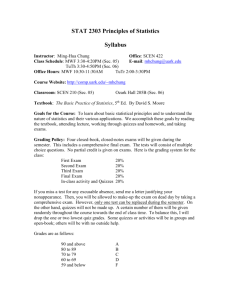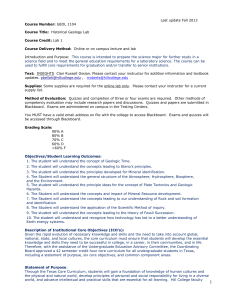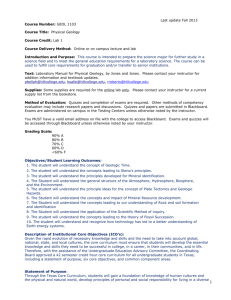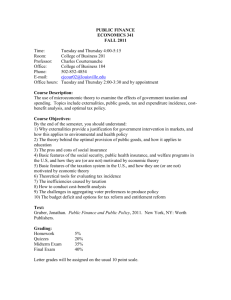Financial Accounting Fundamentals, Accounting 201 Dr. David
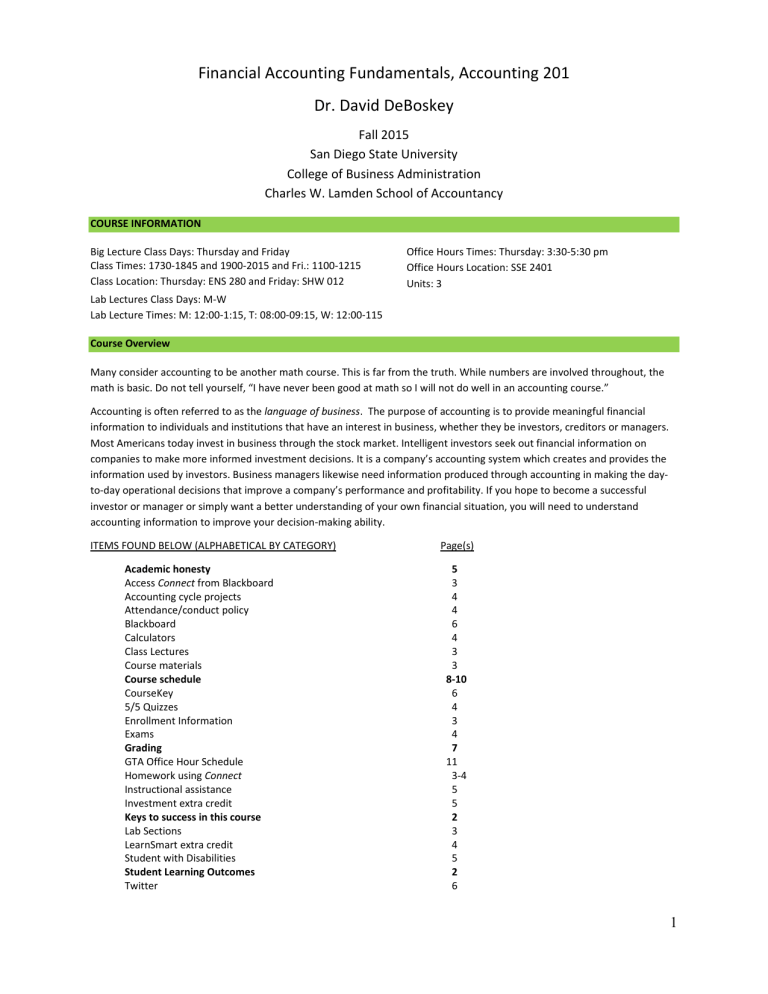
Financial
Accounting
Fundamentals,
Accounting
201
Dr.
David
DeBoskey
Fall
2015
San
Diego
State
University
College
of
Business
Administration
Charles
W.
Lamden
School
of
Accountancy
COURSE INFORMATION
Big Lecture Class Days: Thursday and Friday
Class Times: 1730 ‐ 1845 and 1900 ‐ 2015 and Fri.: 1100 ‐ 1215
Class Location: Thursday: ENS 280 and Friday: SHW 012
Lab Lectures Class Days: M ‐ W
Lab Lecture Times: M: 12:00 ‐ 1:15, T: 08:00 ‐ 09:15, W: 12:00 ‐ 115
Course Overview
Office Hours Times: Thursday: 3:30 ‐ 5:30 pm
Office Hours Location: SSE 2401
Units: 3
Many consider accounting to be another math course.
This is far from the truth.
While numbers are involved throughout, the math is basic.
Do not tell yourself, “I have never been good at math so I will not do well in an accounting course.”
Accounting is often referred to as the language of business .
The purpose of accounting is to provide meaningful financial information to individuals and institutions that have an interest in business, whether they be investors, creditors or managers.
Most Americans today invest in business through the stock market.
Intelligent investors seek out financial information on companies to make more informed investment decisions.
It is a company’s accounting system which creates and provides the information used by investors.
Business managers likewise need information produced through accounting in making the day ‐ to ‐ day operational decisions that improve a company’s performance and profitability.
If you hope to become a successful investor or manager or simply want a better understanding of your own financial situation, you will need to understand accounting information to improve your decision ‐ making ability.
ITEMS FOUND BELOW (ALPHABETICAL BY CATEGORY)
Academic honesty
Access Connect from Blackboard
Accounting cycle projects
Attendance/conduct policy
Blackboard
Calculators
Class Lectures
Course materials
Course schedule
CourseKey
5/5 Quizzes
Enrollment Information
Exams
Grading
GTA Office Hour Schedule
Homework using Connect
Instructional assistance
Investment extra credit
Keys to success in this course
Lab Sections
LearnSmart extra credit
Student with Disabilities
Student Learning Outcomes
Page(s)
8 ‐ 10
6
4
3
4
7
11
6
4
3
3
5
3
4
4
3
4
5
2
6
3 ‐ 4
5
5
2
1
KEYS TO SUCCESS IN THIS COURSE
Students falsely believe that they can wait until the night before the exam, cram everything in, and do just as well as if they were prepared daily.
To do well, you need to attend class each period.
I can help to synthesize the material and point out the key concepts that are needed.
Students generally learn far more in less time inside of class than they do on their own outside of class.
Students should also complete the assigned homework and read the related material in the book.
Don’t be intimidated by the book.
The book is written in a conversational writing style so that it engages students to think not only about how to do accounting but why we do it that way.
A solid conceptual understanding makes learning and remembering the details of any discipline much easier.
Finally, expect that you can learn the material each class.
Do not be concerned by the numbers or the complexity of the topic.
Your goal should be to understand all material each class.
In every class, some students have a natural talent for understanding accounting and do well on the multiple ‐ choice exams, homework, and projects with relatively little effort.
For other students, the ability to learn accounting is more difficult and it seems to be a talent they were born without.
However, my expectation is that all students are willing to put in the time and effort necessary to get the grade they are capable of earning.
If you have honestly put forth your best effort, then be satisfied with your grade and do not get discouraged.
This is just one course in your college career and this probably just means that you have some special talent in another field and will end up hiring an accountant rather than doing it yourself.
Most of all, if at any time you think there is something more that I can do to help you, please don’t hesitate to ask.
I want you to enjoy the course, do the best you can, learn as much as you can, and understand the importance of accounting in our society.
Student Learning Outcomes
The purpose of this course is to introduce students to the fundamentals of financial reporting (what you may know as
“financial accounting”).
More specifically, we will look at the mechanics of financial accounting and the theory behind
United States Generally Accepted Accounting Principles (GAAP) as presented in the statement of operations (i.e., income statement) and the statement of financial position (i.e., balance sheet).
This is a unique class environment because of the wide variety of majors taking the course.
I am
At the end of this course students should be able to:
1.
Use accounting and business terminology, and understand the nature and purpose of generally accepted accounting principles (GAAP).
2.
Explain the objective of financial reporting, the elements of the financial statements, and the related key accounting assumptions and principles.
3.
Define and distinguish between cash basis and accrual basis accounting and the impact of each on the financial statements.
4.
Recognize the information conveyed in each of the four basic financial statements and the way it is used by investors, creditors, regulators, and managers.
5.
Identify and illustrate how internal controls are used to manage and control the firm’s resources and risk.
6.
Explain the nature of current assets including the measuring and reporting of items such as short ‐ term investments, receivables and bad debts, inventory and costs of goods sold, and prepaid expenses.
7.
Explain the valuation and reporting of current liabilities, estimated liabilities, and contingencies.
8.
Identify and illustrate issues relating to the acquisition, use, depreciation, and disposal of long ‐ lived assets.
9.
Identify and illustrate issues relating to the valuation, issuance, and retirement of longterm liabilities.
10.
Be able to account for long ‐ term investments and international business activities.
11.
Identify and illustrate issues relating to stockholders’ equity including the issuance of stock, repurchase of stock, and dividends.
12.
Explain the importance of operating, investing, and financing activities reported in the statement of cash flows when evaluating firm performance and solvency.
13.
Compute and interpret key financial ratios.
14.
Identify the ethical implications inherent in financial reporting and be able to apply strategies for addressing them.
Link to Student Learning Outcomes (SLOS): http://cbaweb.sdsu.edu/assessment/slo
2
Enrollment Information
All enrolled students must meet ALL prerequisites defined by their school or the university
Sophomore standing (30 units completed) is mandatory for this course
Add codes will be determined based on class sizes and seat availability
Course Materials
Book: Financial Accounting 3 rd
ed., Spiceland, Thomas & Herrmann
Homework: Connect ‐ includes an e ‐ book of the entire book
Notes packet: Available at bookstore
Lectures, Homework and Connect Instructions and Attendance Policy
CLASS LECTURES (Auditorium Lab Lectures):
Classes will consist of lectures using PowerPoint slides that are designed to help students better understand the correct financial reporting rules for a variety of common business transactions.
Students are responsible for accessing the slides from the Blackboard website.
The lecture slides will be posted to the Blackboard website under the “Course Documents” tab.
The slides are intended to ease the burden of note ‐ taking during class.
The pace of my lectures are based on the assumption that students have read the textbook material ahead of time, worked through any study modules assigned for pre ‐ class work
and
reviewed
relevant
slides
for
class
(i.e., BE PREPARED FOR CLASS!!).
If you are not prepared for lectures, you will not be maximizing what you can learn from each lecture and your grade will most likely suffer.
LAB SECTIONS:
In addition to the auditorium lectures on Thursdays or Fridays (depending on your section), students are required to attend a
75 ‐ minute lab during the week.
Each lab section is run by a graduate teaching assistant (GTA) from the Charles W.
Lamden
School of Accountancy.
Each GTA is currently pursuing their Masters of Science in Accountancy (MSA) degree at SDSU either through our BMAcc or MSA programs.
Students will be placed in randomly ‐ chosen groups within each lab section.
Labs will generally consist of the following activities:
Lecture on continuing information from previous week (when required)
Demonstration problems
5/5 quizzes (5 questions in 5 minutes) for grade
HOMEWORK
Homework will be assigned throughout the semester and is due by 11:00 p.m.
of the day following the class period .
So, if the class period is on 8/18, homework is due by 11:00 p.m.
on 8/19.
The material on the exams will come directly from the material in the homework.
Students can judge their development in the course by noting how well they understand the homework.
Note that homework is worth 140 points, and EXTRA homework worth 20 is also available.
The extra homework points can be used for missed homework or attendance points but not for other assignments or exams .
All homework problems, including the extra ones, must be completed by the assigned dates.
Points are deducted for late submissions.
If you have trouble using Connect, visit www.mcgrawhillconnect.com/support
or call 1 ‐ 800 ‐ 331 ‐ 5094.
They are very good about offering assistance.
All required online assignments and the interactive eBook for this course are available in Connect .
To access and purchase Connect please do the following:
Connect with a Paired Blackboard Course
To get started, click the first Connect assignment in your Blackboard course.
You'll be prompted to either login with an existing
Connect account username and password, or to create a new account.
Then enter your access code, purchase access online or begin your 14 ‐ day Courtesy Access period.
Once you've completed your selection, you'll arrive at the start of your first Connect
assignment.
3
Purchasing Connect online is the best value for your required course materials – typically half the price of the printed textbook bundle.
In Connect, every question links directly to the eBook.
This means that when you are struggling with a question you can go directly to the explanation in the eBook for help without carrying around a heavy textbook.
You can access the eBook from any computer, any time.
If you also want to purchase a print text, you can buy a discounted loose ‐ leaf version of your book within
Connect with the click of a button.
ATTENDANCE/CONDUCT POLICY
Beginning September 3 , attendance will be taken each period.
You will receive one point for each class and lab attended.
Remember that a class lasts only one hour and fifteen minutes and it would take the student much longer outside of class to understand the material to the same degree.
Attendance will be taken at 5 minutes into each lecture via CourseKey and you must be present to receive credit .
Attendance points will not be given to late arrivals or those that leave early.
If you miss class, you can earn those attendance points by doing extra homework problems .
Students will LOSE five points of their attendance/conduct grade if they disrupt the class in any way, such as leaving early, talking excessively, or other similar distracting behavior.
It is my responsibility to the willing student and to the University to create a learning environment.
Your disruption of that environment will result in a loss of points and could lead to expulsion from the course.
This is a large section of students and it takes only one person to disrupt the whole group.
Please be considerate of those around you.
ACCOUNTING CYCLE PROJECTS
Accounting cycle projects are completed by logging in to Connect .
The projects are designed to demonstrate how transactions are recorded, summarized in account balances, and then reported in financial statements.
The material for the project will be related to the exam soon to follow, so they are meant to provide useful review material for the exams.
Accounting Cycle #1 is due September 28 by 11:00 p.m.
Accounting Cycle #2 is due November 2 by 11:00 p.m.
Accounting
Cycle #3 is due December 9 by 11:00 p.m.
Points are deducted for late submissions.
EXAMS
Exams will consist of multiple ‐ choice questions.
Exams are comprehensive.
The first exam is worth 200 points and covers chapters 1 ‐ 4.
The second exam is worth 250 points – approximately 170 points from chapters 5 ‐ 8 and approximately 80 points from chapters 1 ‐ 4.
The final exam is worth 300 points – approximately 180 points from chapters 9 ‐ 11 and approximately 120 points from chapters 1 ‐ 8.
Exams must be taken at the scheduled time.
No late exams will be given.
If a student misses an exam
for official university ‐ approved activities or for personal reasons (sickness, family emergency, etc.), then the percentage score of the final exam will be applied to the missed exam.
Approval for missing an exam must be obtained before the exam period.
5/5 QUIZZES (Part of Attendance & Participation Grade):
On select weeks 5/5 quizzes will be administered.
These are short 5 question quizzes that must be completed in 5 minutes.
Please see the syllabus for when these 5/5 quizzes are scheduled.
However, pop quizzes are possible at the discretion of the instructor.
Quizzes will consist of multiple choice, fill ‐ in ‐ the ‐ blanks and problems.
Each quiz will be administered at the end of the lab section and covers material from the week’s current material.
It is imperative not to fall behind in this class because of the volume of concepts covered and the sustained pace of the module.
Please be aware that the quizzes are not designed to be wholly representative of the difficulty of questions on the exams.
The quizzes are designed as a tool to ensure that students are keeping up ‐ to ‐ date with the material covered in lectures.
There will be 8 5/5 quizzes during the semester.
The lowest quiz grade may be dropped when calculating the student’s final point tally in the course.
CALCULATORS:
No programmable calculators are allowed to be used during exams.
Only basic function/4 ‐ function calculators will be allowed.
GTA’s will check all students’ calculators before the exams to ensure that each student only has a basic function calculator.
Cell phones cannot be used in any way during exams, not even to check the time.
If a student is seen with a cell phone in his/her hand, that student will receive an automatic zero for that exam.
PAR 289 Scantrons are NEEDED FOR ALL EXAMS.
4
Exams #1 and #2 will start at 8am (Monday lab sections), 10:30am (Tuesday lab sections) and 1pm (Wednesday lab sections).
Exam #3 will start at 6pm for all sections.
LEARNSMART EXTRA CREDIT
LearnSmart is an adaptive learning software.
You will be asked a series of questions over topics in the chapter.
Based on your confidence in your answer and your ability to answer the questions correctly, you will be guided through the assignment until a sufficient level of mastery is achieved.
These assignments are scheduled just before exams to provide a useful study review for the exam.
Points earned can be applied to your exam scores.
INVESTMENT EXTRA CREDIT
By 11:00 p.m.
on September 4 , each student will select one of the investments listed on the “Student Information and
Investment Selection” quiz.
If a student does not select an investment, then the student will not be eligible to earn extra credit points.
On October 16 by 11:00 p.m.
, students will have the option to re ‐ invest in another investment.
The investment game will end at the close of market on December 4 .
For every percentage point that your investment beats my investment, you will earn 2 extra credit points.
If you beat me, the minimum extra credit points will be 4 .
The maximum extra credit possible is 10 points.
INSTRUCTIONAL ASSISTANCE
For purposes of getting help with the material, you should feel free to visit any of the teaching assistants (TAs) during their office hours.
We will hold open office hours where you can attend ANY GTA’s office hours for assistance.
Teaching assistants will be available throughout the week for personal instruction.
Come one come all!!
Beta Alpha Psi, an accounting fraternity, provides free tutoring for this course.
Check the Beta Alpha Psi website at: https://cbaweb.sdsu.edu/bay/tutoring .
Work the self ‐ study quizzes throughout the chapters (answers are provided).
The Connect website offers several features to give you additional assistance – Interactive Presentations, Interactive
Illustrations, Let’s Review problems, and practice problems (Brief Exercises).
Be sure to take advantage of these resources.
Students with Disabilities
If you are a student with a disability and believe you will need accommodations for this class, it is your responsibility to contact
Student Disability Services at (619) 594 ‐ 6473.
To avoid any delay in the receipt of your accommodations, you should contact
Student Disability Services as soon as possible.
Please note that accommodations are not retroactive, and that accommodations based upon disability cannot be provided until you have presented your instructor with an accommodation letter from Student
Disability Services.
Your cooperation is appreciated.
Academic Honesty
The University adheres to a strict policy regarding cheating and plagiarism .
These activities will not be tolerated in this class.
Become familiar with the policy (http://www.sa.sdsu.edu/srr/conduct1.html).
Any cheating or plagiarism will result in
Anyone violating these policies or any other policy announced in conjunction with this class will receive a failing grade for this class and a disciplinary review by Student Affairs.
Examples of Plagiarism include but are not limited to:
Looking at someone else’s quiz or exam paper during a testing period
Using sources verbatim or paraphrasing without giving proper attribution (this can include phrases, sentences, paragraphs and/or pages of work)
Copying and pasting work from an online, offline or any other source directly and calling it your own
Using information you find from an online or offline source without giving the author credit
Replacing words or phrases from another source and inserting your own words or phrases
Submitting a piece of work you did for one class to another class
Brining unapproved notes into a quiz or exam
Writing notes on clothing or body parts while a quiz or exam is in progress
If you have questions on what is plagiarism, please consult the policy and this helpful guide from the Library
5
Course Technology: Blackboard, CourseKey & Twitter
BLACKBOARD:
This course module will be managed via the Blackboard course website.
Therefore, each student needs an email account (either
SDSU Rohan or an alternative email system like Google, Yahoo, Hotmail, etc.).
Please make sure that you update your email address in the SDSU database.
You can check on your Blackboard email account (or update/change it) by going to the SDSU
Web Portal at http://sunspot.sdsu.edu/portal .
Please note that Hotmail accounts sometimes do not accept mail sent directly through Blackboard’s mass email system, but they do receive individual emails.
If you do not receive an announcement via email, you may want to change servers from your Hotmail server to another mail server.
The Blackboard website will be where I make announcements and upload course documents such as lecture slides.
All points for assignments, quizzes and exams that factor into the students’ grades will be posted on Blackboard.
You will also be able to access MyAccountingLab through the
Blackboard website.
COURSEKEY:
We will be using CourseKey ( www.thecoursekey.com
) ‐ a higher education, mobile classroom engagement software that is designed to boost attendance, increase lecture interaction, and facilitate peer ‐ 2 ‐ peer learning.
The web ‐ app combines features to help the professor more efficiently manage the class and allows students to connect more effectively outside of class.
This semester we will be using the CourseKey beta version and you will be able to use the application on any smart device
(smartphone, tablet, laptops, etc.) with a web browser.
If you do not have a smart device please contact support the support team at support@thecoursekey.com
so that arrangements can be made to accommodate you.
Required Browser: Google Chrome
Laptop/PC Chrome Download Link
Android Chrome Download Link
iTunes Download Link (click “View in iTunes” to pull up in iPhone or iPad)
Windows Phone Download Link
*** Disclaimer ***
The software location features work best with the Chrome browser so failure to use the required browser can result in attendance location errors and/or bugs.
Additional browser compatibility will be implemented in the next version.
You can visit the CourseKey Youtube channel for the Student Quick Start Guide which outlines how you will register for a student account, as well as providing a brief overview to get you registered for the class.
CourseKey’s beta version offers a free semester ‐ long subscription .
The first day of class we will go over the integration of the software and how attendance and participation will be graded.
TWITTER:
If you don’t already have a Twitter account, you must sign up for one for the purposes of this course, and follow Professor
DeBoskey (@DRD0315) for the semester
6
Assessments and Grading
Course grades will be assigned in accordance with San Diego State University policy (see General Catalog, pp.
466 ‐ 469).
Undergraduate grades shall be: A (outstanding achievement, available only for the highest accomplishment), B (praiseworthy performance, definitely above average), C (average, awarded for satisfactory performance, the most common undergraduate grade), D (minimally passing, less than the typical undergraduate achievement), F (failing).
Table1.
Your course grade will be based on the following graded components:
Component
Homework
Attendance/Conduct/5 ‐ 5 Quizzes
Accounting Cycle #1
Accounting Cycle #2
Accounting Cycle #3
Exam #1
Exam #2
Exam #3
LearnSmart Extra Credit
Investment Extra Credit
Points
140
60
20
10
20
200
250
300
??
??
Grade of Incomplete .
A grade of Incomplete (I) indicates that a portion of required coursework has not been completed and evaluated in the prescribed time period due to unforeseen, but fully justified, reasons and that there is still a possibility of earning credit.
It is your responsibility to bring pertinent information to the instructor and to reach agreement on the means by which the remaining course requirements will be satisfied.
The conditions for removal of the Incomplete shall be reduced to writing by the instructor and given to you with a copy placed on file with the department chair until the Incomplete is removed or the time limit for removal has passed.
A final grade is assigned when the work agreed upon has been completed and evaluated.
An Incomplete shall not be assigned when the only way you could make up the work would be to attend a major portion of the class when it is next offered.
Contract forms for Incomplete grades are available at the Office of the Registrar website
Letter Grades are based on the normal grading scale of:
C
D
A
B
F
1000 ‐ 900
899 ‐ 800
799 ‐ 700
699 ‐ 600
599 or Below
7
9/3/2015
9/4/2015
9/10/2015
9/11/2015
9/14/2015
9/15/2015
9/16/2015
9/17/2015
9/18/2015
9/24/2015
9/25/2015
9/28/2015
9/29/2015
9/30/2015
Course Schedule
Table 2.
The course schedule, including topics and class activities listed by week, is presented in the following table
DATE(S)
LECTURE/LAB
PERIOD
CHAPTER LEARNING OBJECTIVES HOMEWORK
DUE DATE (by 11:00
PM)
5/5 QUIZ
8/24/2015
8/25/2015
8/26/2015
8/27/2015
8/28/2015
8/31/2015
9/1/2015
9/2/2015
Lab1
L1
Lab2
Introduction
Ch.
1
Ch.
1
None
1 ‐ 6
1 ‐ 6
Technology Introduction/Course Key
Assigned: E1 ‐ 4, E1 ‐ 6, E1 ‐ 8, E1 ‐ 10, E1 ‐
11
Review
8/28/2015
8/29/2015
Yes
SEPTEMBER
4:
LAST
DAY
TO
WITHDRAW
L2
L3
Lab3
L4
L5
Lab4
Ch.
2
Ch.
3
Ch.
3
Ch.
3
Ch.
4
Ch.
2 ‐ 3
1 ‐ 6
1 ‐ 3
4 ‐ 5
6 ‐ 7
1 ‐ 7
Assigned: E2 ‐ 2, E2 ‐ 6, E2 ‐ 8, E2 ‐ 10, E2 ‐
11
Grading and attendance begins
9/4/2015
9/5/2015
Assigned:
Assigned:
E3
E3
Assigned: E3 ‐ 17, E3 ‐ 18, E3 ‐ 19
Assigned: E4 ‐ 10, E4 ‐ 12, E4 ‐ 15, E4 ‐ 16
Accounting
‐
‐
7,
14,
E3
Cycle
‐
E3
8,
‐
E3
15,
‐ 10
E3 ‐
16
#1/Review
Exam 1
9/11/2015
9/12/2015
9/15/2015
9/16/2015
9/17/2015
9/18/2015
9/19/2015
9/25/2015
9/26/2015
9/28/2015
Yes
8
Extra #1 (additional points for homework and attendance): P3 ‐ 1A,
P3 ‐ 5A, P3 ‐ 6A
9/28/2015
DATE(S)
10/5/2015
10/6/2015
10/7/2015
10/8/2015
10/9/2015
10/12/2015
10/13/2015
10/14/2015
10/15/2015
10/16/2015
10/19/2015
10/20/2015
10/21/2015
10/22/2015
10/23/2015
10/26/2015
10/27/2015
10/28/2015
10/29/2015
10/30/2015
11/2/2015
11/3/2015
11/4/2015
11/5/2015
11/6/2015
10/3
(SATURDAY)
‐
EXAM
#1
covers
Chapters
1
‐
4
LECTURE/LAB
PERIOD
CHAPTER LEARNING OBJECTIVES HOMEWORK
DUE DATE (by 11:00
PM)
5/5 QUIZ
Lab5 Ch.
1 ‐ 4
Review 20 most missed questions from Exam 1
L7
Lab6
L8
Lab7
L9
Lab8
L10
Ch.
5
Ch.
5
Ch.
6
Ch.
6
Ch.
7
Ch.
7
Ch.
8
1 ‐ 2, 7 ‐ 8
6 ‐ 6
1 ‐ 4
5 ‐ 8
1, 3 ‐ 4
2, 6 ‐ 8
1 ‐ 6
Assigned: E5 ‐ 3, E5 ‐ 4, E5 ‐ 6, E5 ‐ 15, E5 ‐
17
Assigned: E5 ‐ 8, E5 ‐ 9, E5 ‐ 10, E5 ‐ 11
Assigned: E6 ‐ 2, E6 ‐ 4, E6 ‐ 5
Assigned: E6 ‐ 6, E6 ‐ 10, E6 ‐ 13, E6 ‐ 14
Assigned: E7 ‐ 2, E7 ‐ 9, E7 ‐ 11, E7 ‐ 15
Assigned: E7 ‐ 6, E7 ‐ 17, E7 ‐ 20
E8 ‐ 2, E8 ‐ 10, E8 ‐ 12, E8 ‐ 14
10/9/2015
10/10/2015
10/13/2015
10/14/2015
10/15/2015
10/16/2015
10/17/2015
10/20/2015
10/21/2015
10/22/2015
10/23/2015
10/24/2015
10/27/2015
10/28/2015
10/29/2015
10/30/2015
10/31/2015
Yes
Yes
Yes
Lab9
L11
Ch.
5 ‐ 8
Ch.
1 ‐ 8
Accounting Cycle Project #2 11/2/2015
Yes
Review topics in Chapters 1 ‐ 8
Extra #2 (additional points for homework and attendance): P5 ‐ 3A,
P6 ‐ 2A, P7 ‐ 8A, P8 ‐ 5A
11/5/2015
9
DATE(S)
11/12/2015
11/13/2015
11/16/2015
11/17/2015
11/18/2015
11/19/2015
11/20/2015
12/3/2015
12/4/2015
12/7/2015
12/8/2015
12/9/2015
12/9/2015
12/10/2015
12/10/2015
11/7
(SATURDAY)
‐
EXAM
#2
covers
Chapters
1
‐
8
LECTURE/LAB PERIOD CHAPTER LEARNING OBJECTIVES HOMEWORK
L13 Ch.
9 1, 3 ‐ 4 E9 ‐ 3, EC ‐ 2, EC ‐ 4, EC ‐ 6
DUE DATE (by
11:00 PM)
11/13/2015
11/14/2015
5/5 QUIZ
Lab10 Ch.
1 ‐ 8
Review 25 most missed questions from Exam 2
L14
L15
Lab11
27
Ch.
10
Ch.
11
Ch.
11
Ch.
10 ‐ 12
1 ‐ 3, 5
1 ‐ 2
3
E10 ‐ 1, E10 ‐ 3, E10 ‐ 8
E11 ‐ 8, E11 ‐ 9, E11 ‐ 11
E11 ‐ 3, E11 ‐ 4, E11 ‐ 10, P11 ‐ 4A
11/20/2015
11/21/2015
12/4/2015
12/5/2015
12/8/2015
12/9/2015
12/10/2015
12/9/2015
Yes
29 Ch.
1 ‐ 12
Accounting Cycle #3
Review Final Exam (Time and
Locations TBA)
Extra #3 (additional points for homework and attendance):
P10 ‐ 2A, P11 ‐ 3A, P11 ‐ 4A
12/10/2015
E=Exercises, EC=Exercises in Appendix C, ED=Exercises in Appendix D, P=Problems (Set A) Any Changes to the course schedule, if any, will be announced in class and on blackboard.
10
GTA OFFICE HOUR SCHEDULE
Instructor
Name
Office
Number
Monday
Biggs,
Shannon
2421
130-230
PM
Chung, Yun
Hi
Demina,
Viktoriya
2421
2421
230-330
PM
230-330
PM
Ebraham,
Aiesha
Gross,
Brandon
Hidalgo,
Nathan
Leverton,
Matthew
2421
2422
2422
2422
Tuesday
By Apptmt.
By Apptmt.
By Apptmt.
Wednesday
130-230 PM
By Apptmt.
10-11 AM
Thursday
By Apptmt.
By Apptmt.
By Apptmt.
Friday
By Apptmt.
By Apptmt.
By Apptmt.
130-230
PM
4:30-5:30
PM
By Apptmt. 130-230 PM By Apptmt. By Apptmt.
9-10 AM By Apptmt. 10-11 AM By Apptmt.
330-430
PM
230-330
PM
130-230
PM
By Apptmt.
230-330 PM
By Apptmt.
By Apptmt.
9-10 AM
By Apptmt.
By Apptmt.
Munchus,
Jacki
2422
130-230
PM
9:15-10:15
AM
130-230 PM By Apptmt. By Apptmt.
Zhou, Ying
(Doreen)
2421 By Apptmt. 10-11 AM 130-230 PM By Apptmt.
*Office Location: Student Services East Building (SSE); Office hours are OPEN so please come and someone on duty will try to help you. Please come to office hours prepared with questions.
By Apptmt.
11
12
13
